The White Matter Injury Treatment Market is estimated to be valued at USD 1.2 billion in 2025 and is projected to reach USD 2.9 billion by 2035, registering a compound annual growth rate (CAGR) of 9.1% over the forecast period.
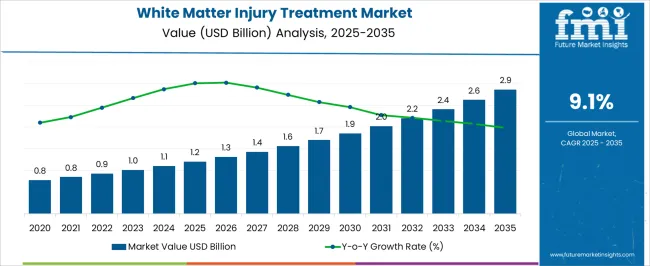
| Metric | Value |
|---|---|
| White Matter Injury Treatment Market Estimated Value in (2025 E) | USD 1.2 billion |
| White Matter Injury Treatment Market Forecast Value in (2035 F) | USD 2.9 billion |
| Forecast CAGR (2025 to 2035) | 9.1% |
The White Matter Injury Treatment market is experiencing steady growth due to increasing prevalence of neurological disorders and rising awareness of treatment options among healthcare providers. The market is primarily being influenced by advancements in therapeutic interventions that target white matter repair and neuroprotection. The demand for effective treatments is being driven by a growing patient population affected by conditions such as perinatal brain injury, stroke, and multiple sclerosis.
Investment in healthcare infrastructure and increasing hospital capacities in both developed and emerging markets have further contributed to market expansion. Research into pharmacological innovations and clinical trials supporting efficacy has strengthened confidence among clinicians, thereby enhancing adoption rates.
The focus on personalized treatment approaches and early intervention is expected to drive the use of drug-based therapies over the coming years As the healthcare ecosystem continues to prioritize neurological care, opportunities for growth in the development and distribution of effective white matter injury treatments are anticipated to expand consistently.
The white matter injury treatment market is segmented by treatment type, end users, and geographic regions. By treatment type, white matter injury treatment market is divided into Drug Based Treatment, Palliative Care, and Symptomatic Treatment. In terms of end users, white matter injury treatment market is classified into Hospitals, Ambulatory Surgery Centre, Emergency Centre, and Others. Regionally, the white matter injury treatment industry is classified into North America, Latin America, Western Europe, Eastern Europe, Balkan & Baltic Countries, Russia & Belarus, Central Asia, East Asia, South Asia & Pacific, and the Middle East & Africa.
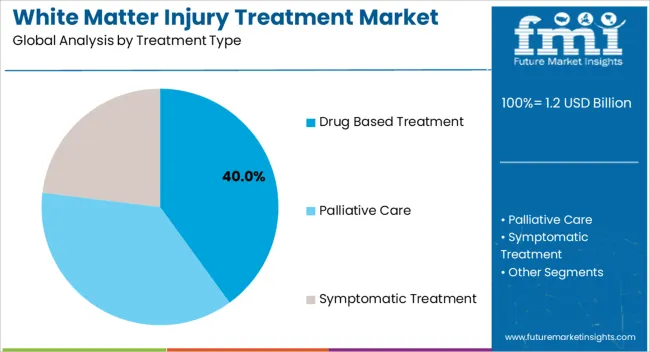
The Drug Based Treatment segment is projected to hold 40.00% of the White Matter Injury Treatment market revenue in 2025, positioning it as the leading treatment type. The growth of this segment is being attributed to the increasing focus on pharmacological interventions capable of promoting remyelination, neuroprotection, and recovery of neurological function.
Adoption has been strengthened by the clinical evidence supporting the effectiveness of drug-based therapies in mitigating long-term disability and improving patient outcomes. Hospitals and specialized neurological centers have been instrumental in expanding the reach of these treatments due to their structured administration protocols and ability to closely monitor patient response.
Additionally, advancements in drug formulation, targeted delivery systems, and combination therapies have contributed to higher efficacy and patient compliance The continued emphasis on early diagnosis and treatment in neurological care settings is expected to further reinforce the dominance of drug-based treatments, making this segment a key driver of overall market growth.
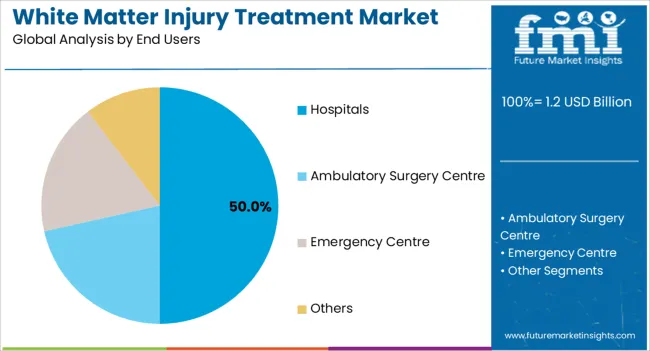
The Hospitals end-use segment is expected to account for 50.00% of the White Matter Injury Treatment market revenue in 2025, emerging as the leading end-user category. This prominence is being driven by hospitals’ capability to provide comprehensive care, including diagnosis, treatment, and post-treatment monitoring for white matter injuries.
The growth of this segment has been supported by the presence of specialized neurology departments, availability of trained medical professionals, and the ability to implement structured drug administration protocols. Hospitals are increasingly integrating advanced imaging, neuro-monitoring, and patient management systems that enhance treatment effectiveness and patient outcomes.
Furthermore, the adoption of standardized treatment guidelines and clinical pathways has contributed to increased utilization of drug-based therapies within hospital settings As hospitals continue to expand neurological care services and invest in research and treatment infrastructure, the demand for white matter injury treatments within this end-use segment is expected to remain robust, sustaining its leadership position in the market.
White matter is a part of brain that works as a cable that connect entire thing together and transmit signals. White matter is tissue made up of nerve fibres in the brain. The fibres are called axons which connect nerve cells and are covered by myelin. The white matter gets it color from myelin.
White matter injury occurs as a consequences of premature birth and can produce long-term neurodevelopmental deficits. White matter injury causes the death of brain tissue around ventricles. White matter injury is majorly occurs due to lack of blood flow to the periventricular are of brain during delivery or either in womb this may result in the death or loss of white tissues.
The babies with white matter Injury does not show obvious symptoms as they are new born, but white matter injury can lead to delayed mental development, motor disorder, hearing and vision impairment. If white matter injury can be accompanied by internal bleeding and may lead to cerebral palsy.
After eight weeks of birth the white matter injury becomes detectable by performing magnetic resonance imaging of the brain or also with ultrasound. There are no accurate cure for white matter injury and no specific treatment is available for white matter injury. The symptomatic and supportive care is the only treatment for white matter injury.
However, maintaining the blood pressure and cholesterol level can also help with managing the white matter injury.
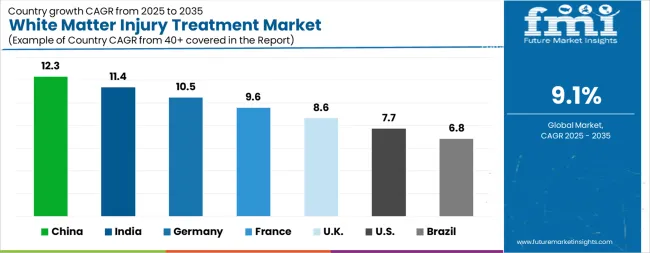
| Country | CAGR |
|---|---|
| China | 12.3% |
| India | 11.4% |
| Germany | 10.5% |
| France | 9.6% |
| UK | 8.6% |
| USA | 7.7% |
| Brazil | 6.8% |
The White Matter Injury Treatment Market is expected to register a CAGR of 9.1% during the forecast period, exhibiting varied country level momentum. China leads with the highest CAGR of 12.3%, followed by India at 11.4%. Developed markets such as Germany, France, and the UK continue to expand steadily, while the USA is likely to grow at consistent rates. Brazil posts the lowest CAGR at 6.8%, yet still underscores a broadly positive trajectory for the global White Matter Injury Treatment Market. In 2024, Germany held a dominant revenue in the Western Europe market and is expected to grow with a CAGR of 10.5%. The USA White Matter Injury Treatment Market is estimated to be valued at USD 422.8 million in 2025 and is anticipated to reach a valuation of USD 890.6 million by 2035. Sales are projected to rise at a CAGR of 7.7% over the forecast period between 2025 and 2035. While Japan and South Korea markets are estimated to be valued at USD 55.5 million and USD 40.1 million respectively in 2025.
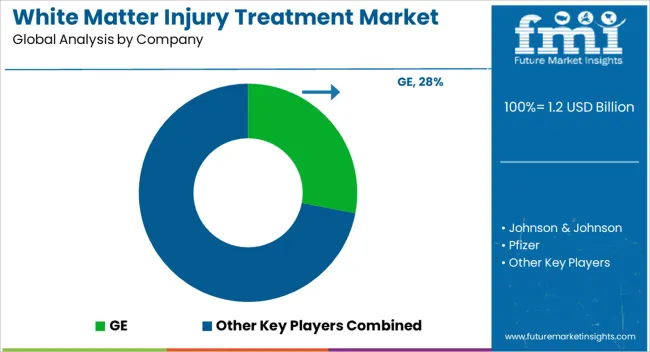
| Item | Value |
|---|---|
| Quantitative Units | USD 1.2 Billion |
| Treatment Type | Drug Based Treatment, Palliative Care, and Symptomatic Treatment |
| End Users | Hospitals, Ambulatory Surgery Centre, Emergency Centre, and Others |
| Regions Covered | North America, Europe, Asia-Pacific, Latin America, Middle East & Africa |
| Country Covered | United States, Canada, Germany, France, United Kingdom, China, Japan, India, Brazil, South Africa |
| Key Companies Profiled | GE, Johnson & Johnson, Pfizer, Kitov Pharma, United Therapeutics, and CJ Group |
The global white matter injury treatment market is estimated to be valued at USD 1.2 billion in 2025.
The market size for the white matter injury treatment market is projected to reach USD 2.9 billion by 2035.
The white matter injury treatment market is expected to grow at a 9.1% CAGR between 2025 and 2035.
The key product types in white matter injury treatment market are drug based treatment, palliative care and symptomatic treatment.
In terms of end users, hospitals segment to command 50.0% share in the white matter injury treatment market in 2025.






Our Research Products

The "Full Research Suite" delivers actionable market intel, deep dives on markets or technologies, so clients act faster, cut risk, and unlock growth.

The Leaderboard benchmarks and ranks top vendors, classifying them as Established Leaders, Leading Challengers, or Disruptors & Challengers.

Locates where complements amplify value and substitutes erode it, forecasting net impact by horizon

We deliver granular, decision-grade intel: market sizing, 5-year forecasts, pricing, adoption, usage, revenue, and operational KPIs—plus competitor tracking, regulation, and value chains—across 60 countries broadly.

Spot the shifts before they hit your P&L. We track inflection points, adoption curves, pricing moves, and ecosystem plays to show where demand is heading, why it is changing, and what to do next across high-growth markets and disruptive tech

Real-time reads of user behavior. We track shifting priorities, perceptions of today’s and next-gen services, and provider experience, then pace how fast tech moves from trial to adoption, blending buyer, consumer, and channel inputs with social signals (#WhySwitch, #UX).

Partner with our analyst team to build a custom report designed around your business priorities. From analysing market trends to assessing competitors or crafting bespoke datasets, we tailor insights to your needs.
Supplier Intelligence
Discovery & Profiling
Capacity & Footprint
Performance & Risk
Compliance & Governance
Commercial Readiness
Who Supplies Whom
Scorecards & Shortlists
Playbooks & Docs
Category Intelligence
Definition & Scope
Demand & Use Cases
Cost Drivers
Market Structure
Supply Chain Map
Trade & Policy
Operating Norms
Deliverables
Buyer Intelligence
Account Basics
Spend & Scope
Procurement Model
Vendor Requirements
Terms & Policies
Entry Strategy
Pain Points & Triggers
Outputs
Pricing Analysis
Benchmarks
Trends
Should-Cost
Indexation
Landed Cost
Commercial Terms
Deliverables
Brand Analysis
Positioning & Value Prop
Share & Presence
Customer Evidence
Go-to-Market
Digital & Reputation
Compliance & Trust
KPIs & Gaps
Outputs
Full Research Suite comprises of:
Market outlook & trends analysis
Interviews & case studies
Strategic recommendations
Vendor profiles & capabilities analysis
5-year forecasts
8 regions and 60+ country-level data splits
Market segment data splits
12 months of continuous data updates
DELIVERED AS:
PDF EXCEL ONLINE
Kids Sports Injury Treatment Market Size and Share Forecast Outlook 2025 to 2035
Acute Kidney Injury Treatment Market Growth - Trends & Forecast 2025 to 2035
Winter Sports Injury Treatment Market Size and Share Forecast Outlook 2025 to 2035
Cutaneous Radiation Injury Treatment Market
Ischemia Reperfusion Injury Treatment Market Size and Share Forecast Outlook 2025 to 2035
White Top Testliner Market Size and Share Forecast Outlook 2025 to 2035
White Inorganic Pigment Market Size and Share Forecast Outlook 2025 to 2035
White Tea Extract Market Size and Share Forecast Outlook 2025 to 2035
Whitening Gold Peptide Complex Market Size and Share Forecast Outlook 2025 to 2035
White Wheat Malt Market Size and Share Forecast Outlook 2025 to 2035
Treatment-Resistant Hypertension Management Market Size and Share Forecast Outlook 2025 to 2035
White Box Server Market Size and Share Forecast Outlook 2025 to 2035
Treatment-Resistant Depression Treatment Market Size and Share Forecast Outlook 2025 to 2035
White Mulberry Leaves Extract Market Growth - Product Type & Form Insights
White Charcoal Powder Market Size, Growth, and Forecast for 2025 to 2035
White Sneakers Market Insights - Size & Forecast 2025 to 2035
Treatment Pumps Market Insights Growth & Demand Forecast 2025 to 2035
White Pepper Market Analysis by Product Type, Form, Application and Distribution Channel Through 2035
White Mineral Oil Market Analysis by Food, Pharmaceutical, Technical Through 2035
Leading Providers & Market Share in White Mushroom Industry

Thank you!
You will receive an email from our Business Development Manager. Please be sure to check your SPAM/JUNK folder too.
Chat With
MaRIA